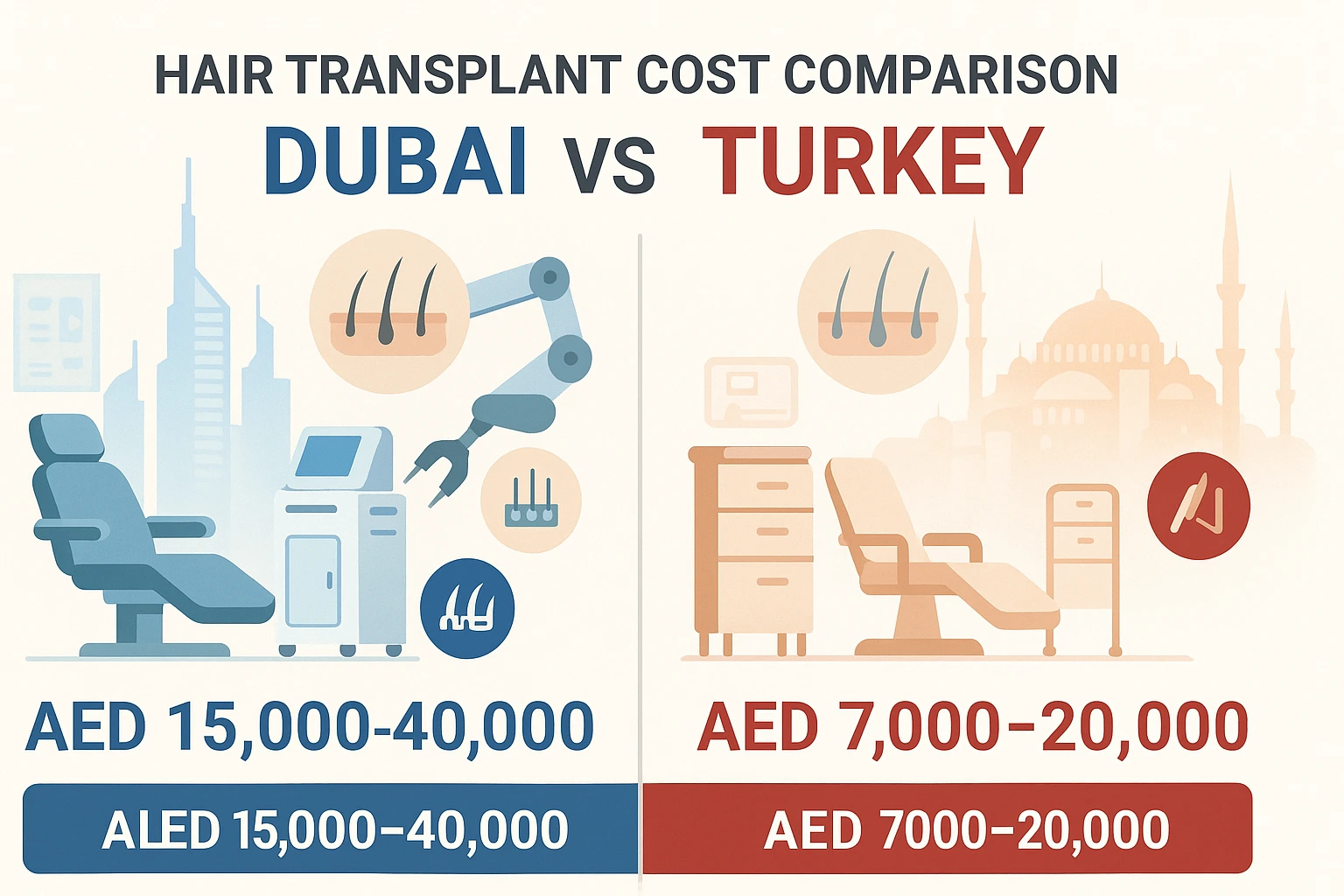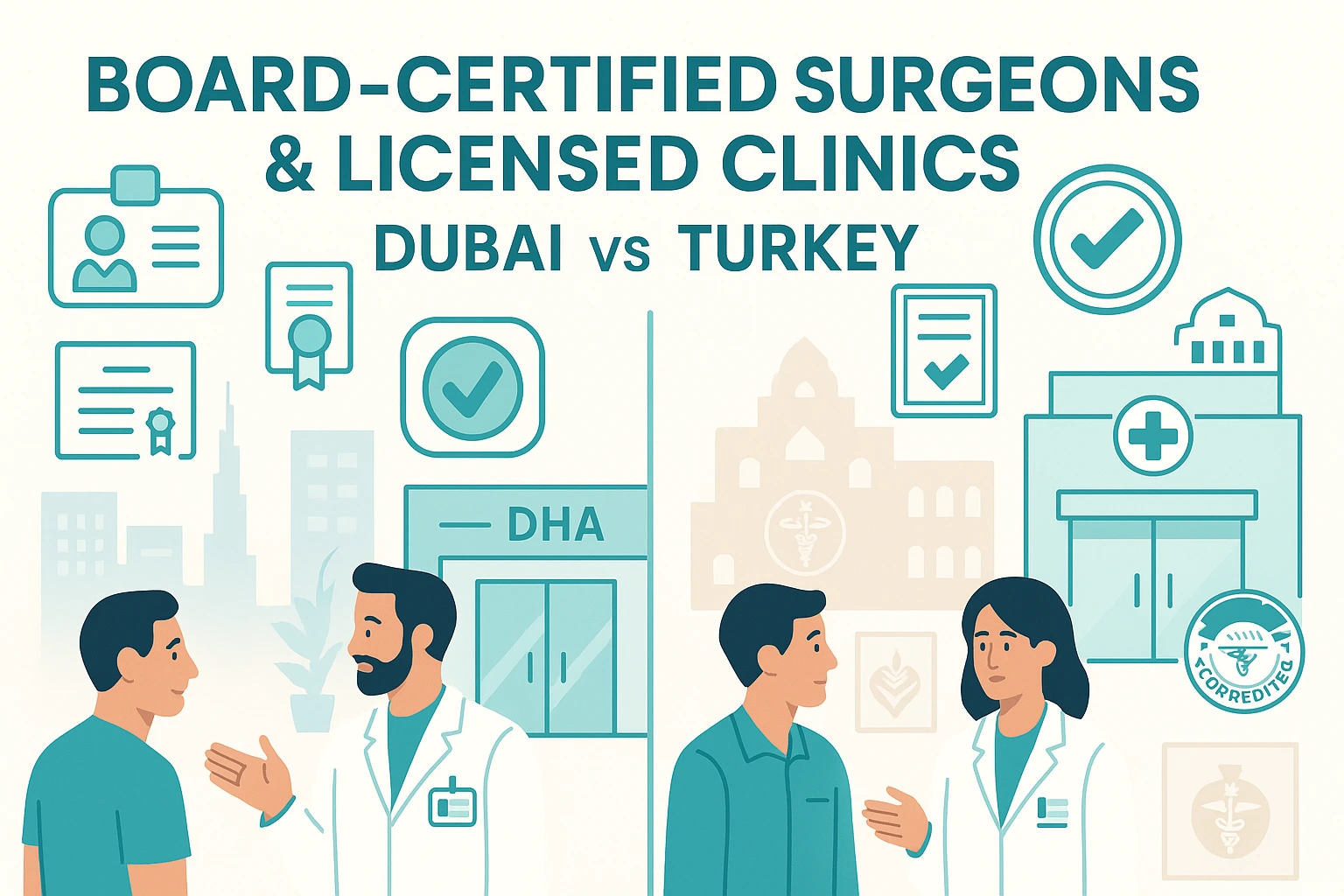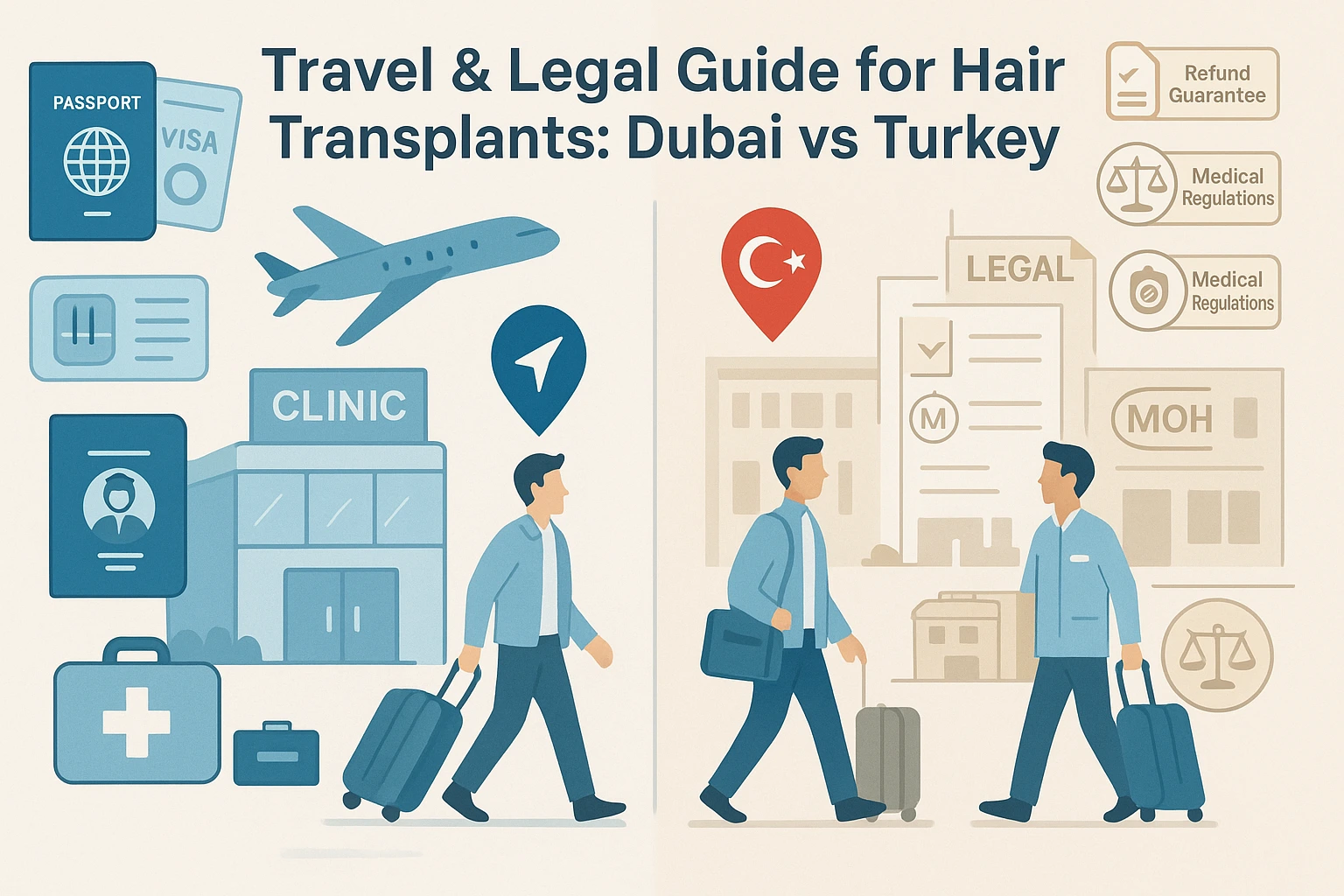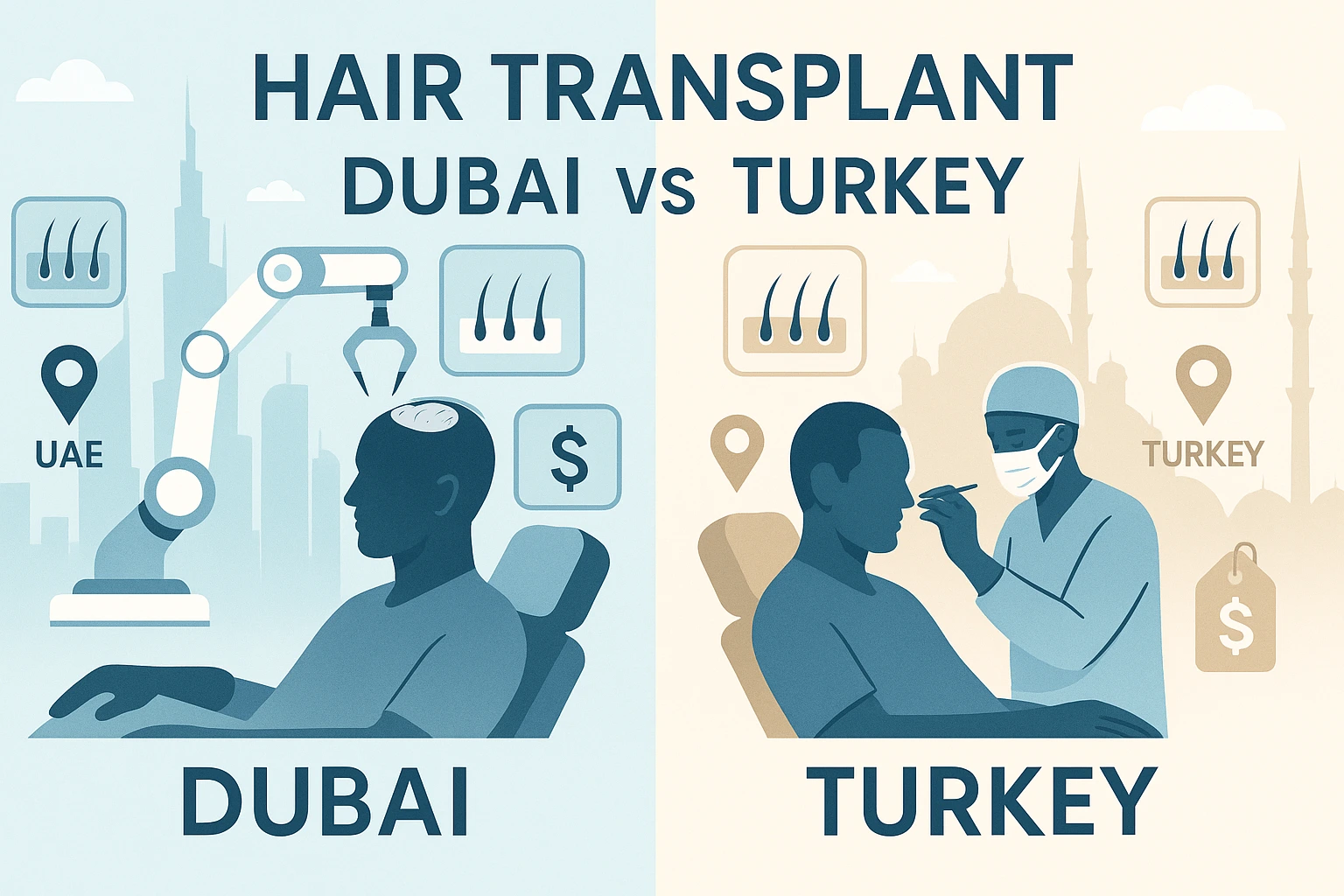The rise of medical tourism for hair restoration has transformed global healthcare decision-making. Patients are no longer restricted by borders —they’re comparing cost per graft, clinic standards, and regulatory quality across continents.
Turkey, attracting over 700,000 international patients annually, has positioned itself as a cost-efficient hub, offering FUE and DHI techniques for as little as $0.70 to $1.10 per graft. Most clinics are ISHRS/EHRS-accredited and operate under high-volume efficiency, enabling robust experience and predictable results.
In contrast, Dubai’s DHA-regulated clinics charge a premium — AED 8–10 per graft — but offer bespoke care, shorter flight access for GCC residents, and luxurious settings. Are you paying more for peace of mind or missing out on bundled convenience?
Whether you’re considering personalized aftercare in Dubai or the turnkey transplant experience in Istanbul, the graft survival rate remains comparable — assuming you choose a properly accredited clinic.
This guide explores everything: cost differences, package structures, clinic regulation, recovery timelines, and what international patients actually prefer — with facts, not fluff.
Comparing Hair Transplant Techniques Used in Dubai and Turkey
Hair transplant techniques are implemented differently across countries, reflecting variations in execution methods, technological tools, and underlying medical philosophies. In Dubai, medical professionals perform Follicular Unit Extraction (FUE) procedures under the strict oversight of the Dubai Health Authority (DHA), leveraging robotic platforms such as ARTAS to minimize human error and ensure procedural consistency. By contrast, clinics in Turkey adopt a surgeon-led manual FUE approach, which offers nuanced control tailored to individual scalp profiles—especially within high-volume treatment centers.
While Dubai emphasizes precision, personalization, and technological enhancement, Turkey prioritizes affordability, scalability, and manual adaptability, both maintaining essential benchmarks like graft survival rates and healing speed. Whether comparing Direct Hair Implantation (DHI) or FUE, the geographic and institutional context significantly redefines the meaning of “technique,” shaped by the interplay of clinical execution, practitioner roles, and systems of care.

Follicular Unit Extraction (FUE)
FUE remains the global benchmark for hair transplantation — yet its application diverges sharply between Dubai and Turkey in terms of regulation, instrumentation, and surgical execution. In Dubai, FUE is tightly regulated by the Dubai Health Authority (DHA), with most clinics leveraging robotic systems like ARTAS to automate follicular extraction. These platforms calibrate incision depth, punch diameter, and graft orientation with machine-level precision, significantly lowering transection risks and promoting faster recovery. Patients often see visible healing within 48 to 72 hours, with minimal scarring and uniform graft placement.
Turkey, on the other hand, champions the manual finesse of surgeon-led FUE. In Turkey, surgeons usually use small tools, either powered or handheld, to carefully adjust the angle and depth of hair grafts as they work, which is especially helpful for uneven scalp shapes or areas with a lot of hair. Recovery typically spans 4 to 6 days, yet clinical outcomes remain competitive, particularly in ISHRS-certified facilities where procedural consistency meets artisanal technique.
In essence, the distinction lies not in what FUE is, but in how it’s performed: automated versus manual, standardized versus adaptive, within the bounds of each nation’s clinical ethos and regulatory architecture.
Direct Hair Implantation (DHI)
In Turkey, Direct Hair Implantation (DHI) is widely accessible and positioned as a mid-tier enhancement within high-volume transplant packages. The procedure relies on Choi implanter pens, which enable surgeons to extract and implant follicles in a single motion — streamlining the process, minimizing follicle handling, and reducing trauma to the scalp. Turkish practitioners are often trained in dense hairline reconstruction and beard transplants, making DHI a preferred method for patients targeting high-density outcomes. Initial healing typically begins within 72 hours, with visible results emerging between four and six months post-procedure.
Dubai presents DHI as a premium, highly curated treatment path. Clinics focus on creating personalized surgical plans, often using DHI along with platelet-rich plasma (PRP) therapy or stem cell serums to improve graft retention and speed up recovery. The Dubai Health Authority (DHA) enforces stringent safety and traceability protocols, aligning the procedure with Dubai’s broader reputation for medical luxury and procedural transparency. While costs are notably higher, the integration of advanced adjunct therapies and meticulous aftercare positions Dubai’s DHI model as a refined option for patients prioritizing customization and clinical elegance.
Both countries achieve consistent outcomes with DHI — yet the philosophy, delivery model, and degree of personalization differ markedly.
Hair Transplant Cost Comparison: Dubai vs Turkey

Hair transplant pricing goes far beyond the graft count — it hinges on what’s bundled, what’s optional, and how each country packages its value proposition. In Dubai, clinics typically charge between AED 8 and 10 per graft, with additional costs for platelet-rich plasma (PRP) therapy, anesthesia, and follow-up consultations. These fees reflect Dubai’s premium-tier healthcare infrastructure, and many DHA-regulated providers bill separately for hotel bookings, aftercare coordination, and concierge support.
Turkey, by contrast, operates on an aggressively inclusive pricing model. Average costs range from $0.70 to $1.10 per graft, often wrapped into comprehensive packages designed for medical tourists. These packages usually cover airport transfers, hotel accommodations, medications, and basic post-operative care — eliminating many of the hidden add-ons seen elsewhere.
However, not all price tags are transparent. Some clinics in both countries advertise low base rates while excluding essentials like pre-op blood tests, DHI-specific tools, or local VAT. Others may charge separately for visa invitation letters or extended recovery stays.
This section breaks down cost-per-graft metrics, package components, and potential hidden fees—offering a clear view of the real financial landscape behind hair transplantation in Dubai vs. Turkey.
| Feature | Dubai 🇦🇪 | Turkey 🇹🇷 |
|---|---|---|
| Average Cost per Graft | AED 8–10 (~$2.18–$2.72) |
$0.70–$1.10 |
| Estimated Cost for 2,000 Grafts | AED 16,000–20,000 (~$4,300–$5,500) |
$1,400–$2,200 |
| PRP Therapy | Often charged separately | Included in many packages |
| Accommodation | Separate or premium plans | Included (3–5 nights) |
| Airport Transfers | Add-on or VIP packages | Usually included |
| Consultation & Scalp Analysis | Separate consultation fee in some clinics | Included in most clinics |
| Post-Operative Medications | Sometimes optional or separate | Usually included |
| Overall Package Type | Modular (build-your-own) | All-inclusive |
Board-Certified Surgeons & Licensed Clinics: Dubai vs Turkey
In hair transplantation, the technique is only part of the equation. Who performs the procedure — and under what system of oversight — often has equal, if not greater, influence on the final outcome. The Dubai Health Authority (DHA) enforces clinical standards in Dubai and requires rigorous licensing for both visiting and local surgeons. Clinics must comply with detailed procedural protocols, and many seek additional accreditation through international health bodies to reinforce credibility and align with global best practices.
Turkey, home to some of the world’s highest-volume transplant centers, operates within a more varied regulatory framework. Clinics are licensed by the Turkish Ministry of Health, while top-tier facilities often pursue voluntary certifications from organizations such as the International Society of Hair Restoration Surgery (ISHRS) or Joint Commission International (JCI). These distinctions signal elevated standards in surgical consistency, hygiene, and patient safety.
Choosing a clinic means evaluating more than surgical technique — it requires understanding who holds the scalpel, where they trained, and how their work is governed. These factors shape not just safety, but predictability, satisfaction, and long-term results.
In this section, we’ll dissect the regulatory ecosystems of Dubai and Turkey, spotlighting credentialed surgeons and certified clinics — backed by global recognition and patient-reported outcomes.

Medical Licensing and International Certification
Trust in a hair transplant surgeon doesn’t start with their technique — it starts with their credentials, the oversight they operate under, and their alignment with international standards. In Dubai, every hair transplant must be conducted under the supervision of a DHA-licensed physician. Surgeons are required to hold accredited medical degrees, pass local competency evaluations, and maintain active compliance with DHA’s evolving clinical protocols. The Dubai Health Authority also enforces strict hygiene and infrastructure benchmarks, with regular audits to ensure ongoing adherence. Many of the city’s top clinics pursue further validation through certifications like ISO and Joint Commission International (JCI), reinforcing their global credibility.
Turkey, while globally renowned for medical tourism, functions within a more flexible regulatory ecosystem. Clinics receive operational licenses from the Turkish Ministry of Health, which oversees basic credentialing and facility standards. Yet not all clinics are created equal. Elite centers distinguish themselves by pursuing optional international recognition — including ISHRS membership, JCI accreditation, or affiliation with the European Hair Research Society (EHRS), particularly when serving a foreign patient base.
The distinction lies in structure: Dubai favors centralized, mandatory oversight; Turkey offers scalable access with optional benchmarks. For patients, the difference translates into crucial pre-op questions: Is your surgeon DHA-licensed or ISHRS-certified? Is the clinic not only licensed but also regularly audited and internationally accredited?
Top Clinics and Reputable Surgeons
In Dubai, premier clinics such as Novomed, Cocoona, and Bizrahmed have established reputations for DHA compliance, international accreditation, and surgeon-led procedural models. These institutions often integrate advanced technologies like the ARTAS robotic system to enhance precision while offering concierge-level services that cater to international patients — including visa assistance, airport transfers, and multilingual medical staff.
Prominent practitioners like Dr. Fadi Al Sabbagh and Dr. Hanieh Erdmann stand out for their consistently high graft survival rates, meticulous aesthetic designs, and DHA-backed medical licensing — reinforcing Dubai’s appeal to patients seeking regulated, high-touch experiences.
Turkey, by comparison, delivers scale and specialization through a vast network of high-volume transplant centers. Clinics such as HWT Clinic, Este Favor, and HairPalace dominate the international market, offering ISHRS-affiliated services, English-speaking teams, and expertise in dense-packing techniques across both FUE and DHI. These procedures are often delivered at a fraction of Dubai’s cost—without compromising technical quality.
Renowned Turkish surgeons include Dr. Ahsen Farooque, celebrated for his precision in DHI, and Dr. Ziakas, known for publishing peer-reviewed outcomes in international journals. Many of these clinics bolster credibility with expansive before-and-after galleries, verified patient reviews, and transparent procedural reporting.
Together, these surgeon-clinic ecosystems reflect the broader strengths of each country: Dubai emphasizes regulated precision and boutique care, while Turkey offers high-volume expertise and global accessibility.
Here’s how leading clinics in Dubai and Turkey compare across trust factors, technology, and international patient readiness:
| Feature | Dubai 🇦🇪 | Turkey 🇹🇷 |
|---|---|---|
| Top Clinics | Novomed, Cocoona, Bizrahmed | HWT Clinic, Este Favor, HairPalace |
| Regulatory Body | Dubai Health Authority (DHA) | Turkish Ministry of Health |
| Surgeon Certifications | DHA License, JCI Accreditation | ISHRS, EHRS, JCI (optional) |
| Technology Used | ARTAS Robotics, PRP Add-ons | Manual FUE/DHI, Choi Pen, PRP |
| Language Support | English, Arabic, Hindi | English, German, Arabic, French |
| Before/After Transparency | Offered via consultations and clinic websites | Public galleries, patient groups, YouTube |
Travel & Legal Guide for Hair Transplants: Dubai vs Turkey
In Dubai, entry is seamless for most nationalities, with visa-on-arrival privileges extended to travelers from numerous countries. For medical tourists, expedited visa processing is often available, and clinics typically assign international patient coordinators to manage logistics — from airport transfers and scheduling to language support. English is widely spoken, reducing friction in both medical consultations and daily interactions.
Turkey has similarly streamlined its medical tourism process, particularly for patients traveling from Europe, the Middle East, and North Africa. Many clinics provide visa support letters and maintain multilingual teams trained in cultural sensitivity, post-op communication, and international aftercare coordination.
Yet beyond logistics and language, patients must consider the “what if” scenarios. What protections exist if results fall short, revisions are needed, or complications arise? Understanding your legal rights—including refund policies, revision protocols, and malpractice coverage—is essential for informed decision-making.
In this section, we’ll map the full patient journey—from visa processes and translation services to legal safety frameworks — so you can evaluate not just where treatment is possible but where it’s protected.

UAE Visa Options for Indian Citizens (2025)
| Visa Type | Eligibility | Duration | Fees (AED) | Where to Apply |
|---|---|---|---|---|
| Visa on Arrival | Indian citizens with valid US, UK, EU, Canada, Australia, etc. visa or residence | 14 days (extendable by 14 days) | AED 100 + AED 250 for extension | UAE Airport (on arrival) |
| Pre-arranged 30-Day Visa | All Indian passport holders | 30 days (single entry) | AED 350 | Airlines / Travel Agencies / UAE Hotels |
| Pre-arranged 60-Day Visa | All Indian passport holders | 60 days (single entry) | AED 650 | Authorized visa agents / UAE sponsors |
| Multiple Entry Visa | Business, tourism, or medical travelers | 30/60 days, multiple entries | AED 650–1000 | Apply before travel |
| Transit Visa | Connecting flights via UAE (3rd country required) | 48 or 96 hours | Free (48 hrs) / AED 50 (96 hrs) | Through airline prior to flight |
Language, Communication, and Cultural Barriers
One of Dubai’s most compelling advantages for hair transplant patients is its globally attuned clinical environment. Reputable clinics consistently employ fluent English-speaking medical staff — from surgeons and consultants to international patient coordinators — ensuring seamless communication at every stage. This clarity is vital for informed consent, procedural transparency, and effective post-operative care.
For travelers from India, Pakistan, Bangladesh, and the broader GCC, many clinics go a step further by offering support in Hindi, Tamil, Urdu, Arabic, and Tagalog. For less commonly spoken languages, professional medical interpreters are available upon request, helping bridge communication gaps during critical moments in the treatment process.
Culturally, Dubai’s healthcare sector is shaped by its cosmopolitan makeup. Clinics are recognized for their hospitality and cross-cultural sensitivity, creating a setting where patients from diverse backgrounds feel respected and understood. From multilingual intake forms to personalized discharge instructions, communication is designed to align with patient preferences — enhancing comfort, comprehension, and overall care continuity.
Legal Protections for Medical Tourists
Hair transplant procedures in Dubai are governed by the stringent regulations of the Dubai Health Authority (DHA), which mandates that all licensed clinics meet internationally recognized standards for hygiene, patient safety, and procedural efficacy. For medical tourists, this oversight translates into a structured framework of legal protection — spanning from pre-operative consultation to post-operative recovery.
Most DHA-accredited clinics provide written refund and revision policies, addressing rare but possible complications such as poor graft take or aesthetically unsatisfactory results. Prior to surgery, patients are strongly advised to verify whether the clinic includes:
- Guaranteed revision surgery for suboptimal outcomes
- Partial refund eligibility in the event of surgical failure or patient dissatisfaction
- Coverage under UAE medical malpractice laws for procedural liability
Although the specific terms — including refund percentages and revision criteria — can differ by clinic, having these commitments documented in writing offers a vital safeguard for international patients. Reputable clinics are transparent about their patient rights policies and post-procedure dispute protocols.
Moreover, all aesthetic procedures in Dubai, including hair restoration, fall under the UAE’s legal framework for medical malpractice. This allows patients to formally file complaints or pursue legal action in the case of verified negligence — provided the clinic is DHA-certified and operating within approved guidelines.
For anyone considering cross-border treatment, legal clarity is as important as medical competence — and in Dubai, both are built into the system.
Aftercare & Healing: What to Expect After a Hair Transplant
While both Dubai and Turkey offer cutting-edge hair restoration techniques, their aftercare ecosystems, clinical follow-up models, and healing environments diverge in ways that directly influence recovery comfort, hair regrowth speed, and long-term satisfaction.
In Dubai, recovery is typically guided by a structured and regulated care continuum. Patients receive tailored aftercare kits, access to teleconsultation platforms, and, in many cases, in-clinic follow-ups for PRP therapy or scalp assessments. Clinics often design their recovery programs to accommodate both local and extended-stay international patients — reinforcing Dubai’s identity as a hub for luxury medical healing.
Turkey, on the other hand, favors a streamlined, bundled aftercare model. Most clinics provide comprehensive medication packs, written healing protocols, and ongoing support via WhatsApp or other messaging platforms. Once the patient departs, recovery becomes largely self-directed — a trade-off that appeals to value-driven travelers seeking affordability without forfeiting core medical support. Environmental conditions such as coastal humidity or drier inland climates can also affect recovery comfort, influencing factors like scab shedding and scalp sensitivity.
This section breaks down the recovery timeline, post-op support options, and follow-up structures in both countries — helping you decide not only where to undergo your procedure, but how you want to heal.

Healing Timelines in Dubai vs Turkey
| Healing Factor | Dubai 🇦🇪 | Turkey 🇹🇷 |
|---|---|---|
| Initial Healing Begins | 48–72 hours post-procedure | 3–5 days post-procedure |
| Scab Shedding Completion | 7–10 days | 7–10 days |
| Visible Regrowth Begins | 2–3 months | 3–4 months |
| Recovery Influencers | PRP therapy, ARTAS automation, dry climate | Manual FUE, clinic volume, local humidity |
| Environment Impact | Low sweat risk, fast healing in sterile conditions | Possible itching in humid areas like Istanbul |
| Follow-Up Method | In-person reviews, teleconsults (local and expat patients) | Remote follow-up via WhatsApp and video calls |
Which Destination Is Best for You?
| Profile Type | Dubai is Ideal For… | Turkey is Ideal For… |
|---|---|---|
| Budget-Conscious Traveler | Not ideal due to higher per-graft cost unless bundled offers apply | ✅ Very cost-effective — perfect for high-graft sessions at lower rates |
| Luxury-Minded Medical Tourist | ✅ Ideal for VIP-level care, DHA-certified clinics, and 5-star recovery | Some luxury options, but not as consistent in post-op services |
| Short-Term Visitor | ✅ Accessible and quick recovery in a clean, controlled setting | May require longer stay for recovery + follow-up logistics |
| Expats in the Gulf Region | ✅ Convenient, regional travel with local-language support | Only ideal if combining treatment with vacation |
Hair transplant costs in Dubai typically range from AED 15,000 to AED 40,000 depending on the technique used and number of grafts. See detailed pricing breakdowns, surgeon fees, and bundled offers in our full Dubai cost guide →
Conclusion
Dubai and Turkey continue to dominate the global hair transplant landscape in 2025, each offering distinct advantages tailored to different patient needs. Dubai distinguishes itself through its DHA-regulated clinics, adoption of advanced technologies like DHI and robotic FUE, and luxury-tier medical tourism packages designed for patients prioritizing safety, personalization, and high-touch aftercare. Turkey, meanwhile, remains a powerhouse for high-volume, cost-efficient transplants, making it especially attractive to those seeking maximum graft yield within a budget-conscious framework.
Visa access is streamlined for Indian passport holders in both countries, and multilingual medical teams help eliminate most communication barriers. Beyond the procedure itself, recovery protocols, follow-up infrastructure, and legal protections also diverge. Dubai clinics often provide telemedicine access, structured post-op support, and GCC-friendly recovery logistics, while Turkey offers bundled post-op care, WhatsApp-based follow-ups, and scalable solutions for international patients.
Ultimately, the ideal destination depends on your goals: Turkey offers affordability and scale, whereas Dubai delivers regulatory rigor, clinical refinement, and concierge recovery. By evaluating pricing structures, surgical techniques, accreditation standards, and verified patient outcomes, you can make an informed choice that aligns with your expectations for both the journey and the result.
FAQs for Hair Transplant Dubai vs Turkey
Choosing a destination for a hair transplant is a major decision — especially when it involves international travel. To help you move forward with clarity, we’ve compiled answers to some of the most frequently asked questions related to safety, refunds, and revision policies across both Dubai and Turkey. These responses are based on verified clinic policies, industry standards, and medical tourism insights.
Dr. Aisha Rahman is a board-certified internal medicine specialist with over 12 years of clinical experience in chronic disease management and preventive healthcare. She has worked at leading hospitals across the UAE, helping patients manage conditions such as diabetes, hypertension, cardiovascular diseases, and metabolic disorders.
A strong advocate for preventive medicine, Dr. Rahman emphasizes early diagnosis, lifestyle modifications, and patient education to reduce chronic illness risks. She is an active member of the Emirates Medical Association and has contributed to health awareness programs and medical research initiatives. Her expertise has been featured in The National UAE, Gulf Health Magazine, and leading medical journals. As a keynote speaker at healthcare conferences, she shares insights on evidence-based treatments, patient-centered care, and advancements in internal medicine.


